|
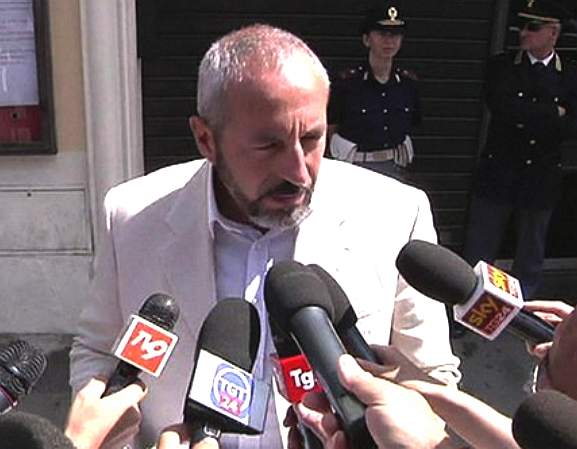
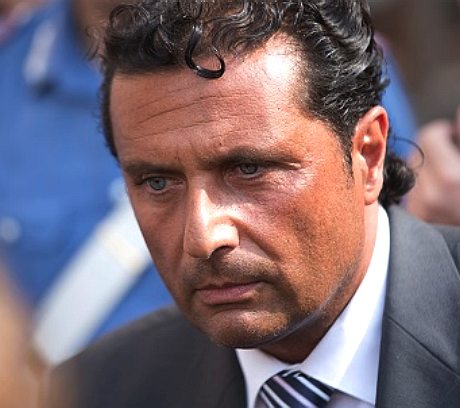
ITALY,
GROSSETO MONDAY JULY 22 2013 - FIVE CONVICTED
Five employees of an Italian cruise company for the Costa Concordia shipwreck that killed 32 crew and passengers were convicted in an Italian court on Saturday after it accepted their plea bargains.
The longest sentence went to the crisis coordinator for Costa Crociere SpA, the cruise company, who was sentenced to two years and 10 months. Concordia's hotel director was sentenced to two years and six months while two bridge officers and a helmsman got sentences ranging from one year and eight months to one year and 11 months.
The Concordia, on a week-long Mediterranean cruise, speared a jagged granite reef when, prosecutors allege, Schettino steered the ship too close to Giglio's rocky shores as a favor to a crewman whose relatives live on the island. If found guilty, he faces up to 20 years in prison. Schettino has denied the charges and insisted that the rock was not in nautical maps.
Five employees of an Italian cruise company were convicted Saturday of manslaughter in the Costa Concordia shipwreck that killed 32 people, receiving sentences of less than three years that lawyers for victims and survivors criticized as too lenient.
The guilty verdicts for multiple manslaughter and negligence were the first reached in the sinking of the cruise liner carrying more than 4,000 crew and passengers near the Tuscan shore in January 2012.
The ship's captain, the only remaining defendant, was denied a plea bargain and is being tried separately. He faces up to 20 years, if convicted of manslaughter, causing the shipwreck and abandoning the ship.
Schettino is charged with manslaughter for causing the January 2012 shipwreck off the Tuscan island of Giglio and abandoning the vessel with thousands aboard.
On Saturday, lawyers representing the 32 victims of the shipwreck said the sentences of the plea bargain — a fraction of what is usually handed down for manslaughter — were inadequate given the gravity of the disaster.
"It seems like a sentence for illegal construction," said lawyer Massimiliano Gabrielli. "It's an embarrassment."
Another lawyer for victims, Daniele Bocciolini, called the sentences "insufficient" and questioned the prosecutors' hypothesis placing the lion's share of the blame on Capt. Francesco Schettino.
The five employees of the Costa Crociere SpA cruise company were charged for their respective roles in the nautical maneuver that put the ship in peril, evacuation and response to the emergency.
The longest sentence went to the company's crisis coordinator, who was sentenced to two years and 10 months. Concordia's hotel director was sentenced to two years and six months, while two bridge officers and a helmsman got sentences ranging from one year and eight months to one year and 11 months.
The bridge officials and helmsman were also convicted of a charge of causing a shipwreck, in addition to multiple manslaughter and negligence.
The court's reasoning for its decision will be released within 90 days, as is standard in Italy.
Prosecutors accused the crisis coordinator, who wasn't aboard the ship, of downplaying the severity of the emergency and delaying adequate response, while the hotel director was charged for his role in the evacuation, described by passengers as chaotic.
The helmsman was blamed for steering the ship in the wrong direction after Schettino ordered a corrective maneuver.
Prosecutor Francesco Verusio said the convictions confirmed investigators' version of events.
"I don't think there are any more doubts about the responsibility that falls above all on the shoulders of Schettino," Verusio said.
Schettino is charged with manslaughter for causing the shipwreck off the Tuscan island of Giglio and abandoning the vessel with thousands aboard. That trial opened this week, and was continued after two hearings until the end of September.
The Concordia, on a week-long Mediterranean cruise, speared a jagged granite reef when, prosecutors allege, Schettino steered the ship too close to Giglio's rocky shores as a favor to a crewman whose relatives live on the island. Schettino has denied the charges and insisted that the rock was not in nautical maps.
The reef sliced a 70-meter-long (230-foot) gash in the hull. Seawater rushed in, causing the ship to rapidly lean to one side until it capsized, then drifted to a rocky stretch of seabed just outside the island's tiny port.
Survivors have described a delayed and confused evacuation. The bodies of two victims were never found, but they were declared dead after a long search.
Costa
Crociere, part of the American-based Carnival Corporation, agreed to pay a $1.3m (£860,000) fine in April to settle possible criminal charges.
Most passengers have already accepted compensation of about 11,000 euros ($14,200: £9,400) each, but remaining groups of survivors are holding out for more.

LATEST
16 DECEMBER 2012
Ever since the wreck of the Costa Concordia 11 months ago, the huge Italian luxury liner has been sitting, semi-submerged, off the coast of Tuscany, looking like a big, beached
whale.
It's the largest passenger ship ever capsized, easily surpassing the Titanic.
Removing the ship has turned out to be the most complicated, the most expensive, the most daunting and the riskiest
salvage operation ever.
The Costa Concordia is a rusting carcass, sitting pon two underwater mountain peaks.
A clock remains frozen in time, marking the hour and minute when the ship lost power.
Below the waterline ghostly vestiges of the ship's contents litter the ocean floor in what the Italian authorities have designated an official crime scene. Thirty people died; two are still missing.
Nick Sloane is the senior salvage master, a South
African. Two salvage
teams working together plan to roll the 60,000-ton ship in one piece onto an underwater platform, raise it and then float it away so it can be cut up for scrap.
To keep things in perspective, this ship is three football fields long. The actual work is being shared by Nick Sloane's Titan Salvage, an American
company, and Micoperi, an Italian engineering firm. Sergio Girotto is the company's project director,
in charge of re-floating a 60,000-ton ship filled with seawater.
The engineers are going to, in effect, weld a new ship onto the
shipwreck, beginning with the construction of towering steel boxes called
"sponsons". We wish them the best of luck with that and will
report on the project in the coming months.
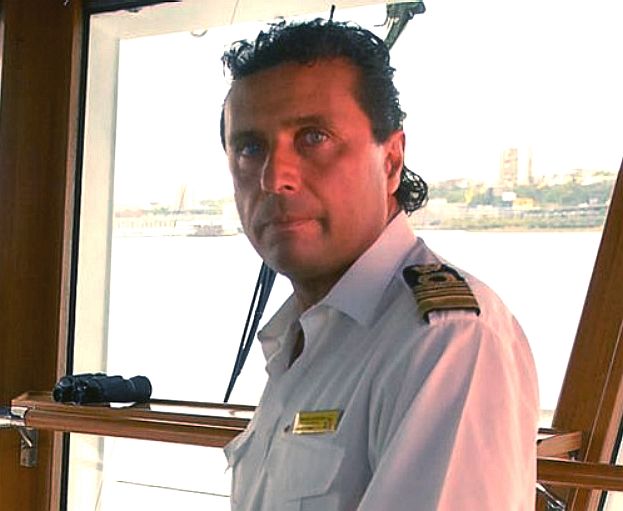
CAPTAIN
FRANCESCO SCHETTINO NEGLIGENCE CHARGES March 2102
"That evening Schettino had left his reading glasses in the cabin and repeatedly asked Ambrosio to look at the radar to check the route," Ambrosio's lawyer Salvatore Catalano said outside a pre-trial hearing on the accident on Saturday.
Ambrosio had made the allegation about Schettino, 51, to investigating magistrates at previous hearings, lawyer Salvatore Catalano added.
Schettino has said that the rock hit by the cruise liner was not on his navigational charts.
The captain has acknowledged that he brought the ship too close to the shore, but he says he was not the only one to blame for the tragedy.
Catalano said first officer Ambrosio ordered the evacuation of the listing vessel before the captain had made up his mind to do it.
"He ordered the lifeboats to be put to sea from deck number four," Catalano said.
None of those under investigation attended the closed-door hearing in the Tuscan city of Grosseto, which was held in a theatre to accommodate hundreds of victims' relatives, survivors and lawyers for all sides.
Schettino's lawyer, Bruno Leporatti, did not specifically address the latest accusations levelled by the first officer against the captain, who has already been held up to condemnation and ridicule around the world.
Schettino is accused of a string of charges including multiple manslaughter and abandoning the 114,500-tonne liner before the evacuation of all passengers and crew. He is under arrest at his home in Meta di
Sorrento, near Naples.
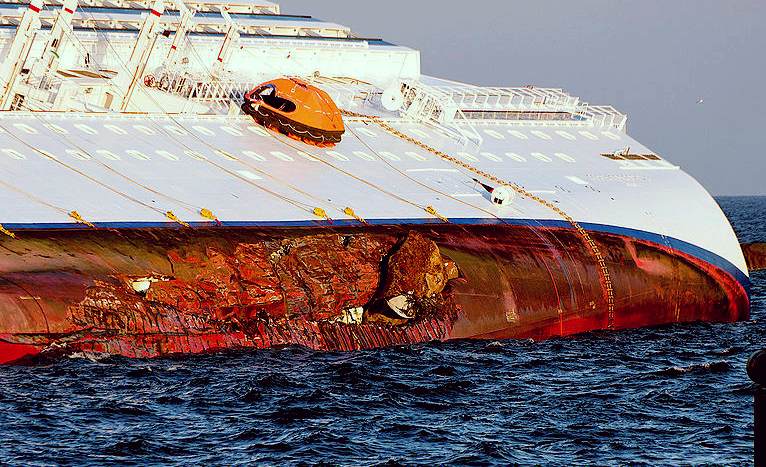
BACKGROUND
MS Costa Concordia
was a Concordia-class cruise ship operated by Costa Crociere (a subsidiary of Carnival Corporation) and built by the Fincantieri's Sestri Ponente yards in Italy. The name Concordia was intended to express the wish for "continuing harmony, unity, and peace between
European nations."
Costa Concordia was the first of the Concordia class cruise ships, followed by sister ships Costa Serena, Costa Pacifica, Costa Favolosa and Costa Fascinosa, and Carnival Splendor built for Carnival Cruise Lines. When the 114,137 GT Costa Concordia and her sisters entered service, they were among the largest ships built in Italy until the construction of the 130,000 GT Dream class cruise ships.
On 13 January 2012 at about 9:45 pm, in calm seas and overcast weather, under command of Captain Francesco Schettino, Costa Concordia struck a rock in the Tyrrhenian Sea just off the eastern shore of Isola del Giglio, off the western coast of
Italy about 100 km (62 mi) northwest of
Rome. This tore a 50 m (160 ft) gash on the port (left) side of her hull, which almost immediately flooded parts of the engine room and caused loss of power to her propulsion and electrical systems. With water flooding in and listing, the ship drifted back to Giglio Island, where she grounded just 500 m (550 yd) north of the village of Giglio Porto, lying on her starboard (right) side in shallow water with most of her starboard side under water. Despite the gradual sinking of the ship, its complete loss of power, and its proximity to shore in calm seas, an order to abandon ship was not issued until over an hour after the initial impact. Although international maritime law requires all passengers to be evacuated within 30 minutes of an order to abandon ship, the evacuation of Costa Concordia took over six hours and not all passengers were evacuated. Of the 3,229 passengers and 1,023 crew known to have been aboard, 30 bodies have been located, and two more passengers are missing and presumed
dead.
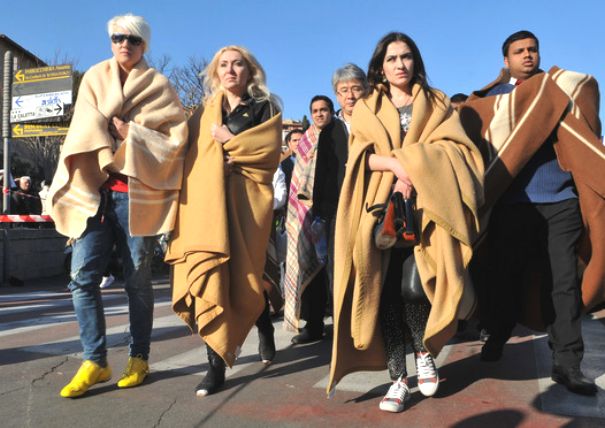
Concept and construction
The largest Italian cruise ship ever conceived, Costa Concordia was ordered on 19 January 2004 by Carnival Corporation in Fincantieri and built in the Sestri Ponente yard in Genoa, as yard number 6122. At the vessel's launch at Sestri Ponente on 2 September 2005, the champagne bottle, released by model Eva Herzigová, failed to break, an inauspicious omen in maritime superstition. The ship was delivered to Costa on 30 June 2006. She cost €450 million (£372 million,
US$570 million) to build.
Description
Costa Concordia is 290.20 metres (952 ft 1 in) long, with a beam of 35.50 metres (116 ft 6 in) and a draught of 8.20 metres (26 ft 11 in). She is equipped with a
diesel-electric propulsion with six 12-cylinder Wärtsilä 12V46C four-stroke medium-speed diesel generating sets with a combined output of 75.6 megawatts (101,400 hp) and two 21-megawatt
electric motors connected to fixed-pitch
propellers. Her service speed is 19.6 knots (36 km/h; 23 mph), but during sea trials, she achieved a speed of 23
knots (43 km/h; 26 mph).
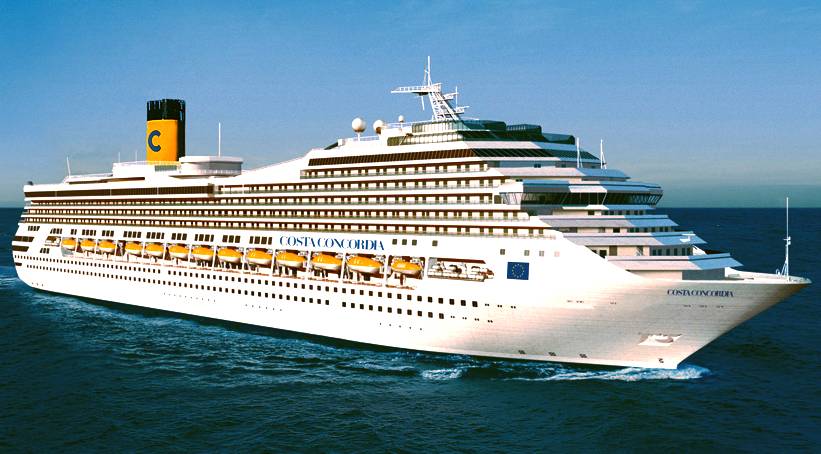
Layout
- Costa Concordia has 13 public decks; Deck 1 is the lowest:
Deck 1 Olanda
Deck 2 Svezia
Deck 3 Belgio
Deck 4 Grecia
Deck 5 Italia
Deck 6 Gran Bretagna
Deck 7 Irlanda
Deck 8 Portogallo
Deck 9 Francia
Deck 10 Germania
Deck 11 Spagna
Deck 12 Austria
Deck 13 Polonia
Amenities
Costa Concordia has approximately 1,500 cabins; 505 have private balconies and 55 have direct access to Samsara Spa and are considered Spa staterooms; 58 suites have private balconies and 12 have direct access to the spa. Costa Concordia has one of the world's largest exercise facility areas at sea, the Samsara Spa, a two-level, 6,000 m2 (64,600 sq ft) fitness center, with gym, a thalassotherapy pool, sauna, Turkish bath and a
solarium. The ship had four swimming pools, two with retractable roofs, five jacuzzis, five spas, and a poolside movie theater on the main pool deck.
There are five onboard restaurants, with Club Concordia and Samsara taking reservations-only dining. There are thirteen bars, including a cigar and cognac bar and a
coffee and chocolate bar.
Entertainment options include a three-level theatre, casino, and a futuristic disco. There is a children's area equipped with video game products. The ship has a Grand Prix motor racing simulator and an
internet café.
Accidents and incidents
2008 bow damage
On 22 November 2008, Costa Concordia suffered damage to her bow when high winds over the Sicilian city of Palermo pushed the ship against its dock. There were no injuries and repairs started soon after.
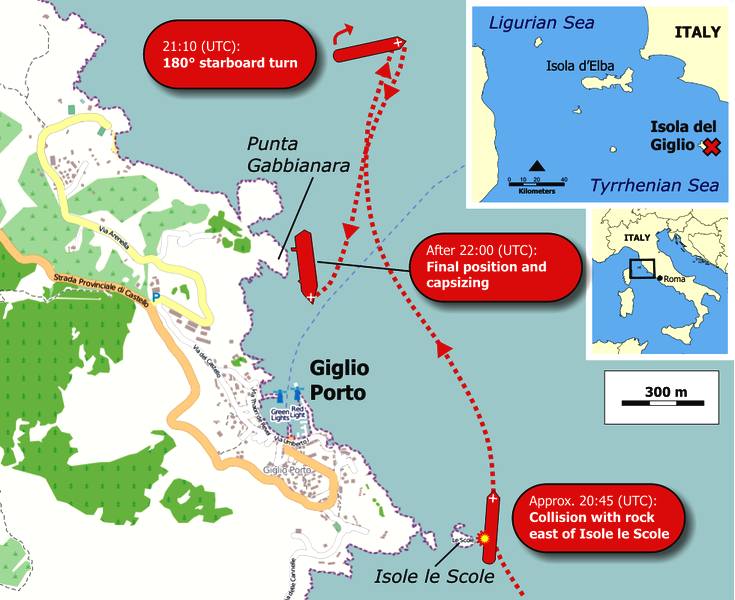
2012 grounding and partial sinking
On 13 January 2012, at 21:45 local time (UTC+1), Costa Concordia hit a rock off Isola del Giglio (42°21′55″N 10°55′17″E). A 50-metre (164 ft) long gash was made in the hull, along 3 compartments of the engine room (deck 0); power to the engines and ship services was cut off. Taking on water, the vessel started to list to port. Without power, the ship drifted astern but was now listing heavily to starboard. The ship, pushed by winds laterally, drifted back and grounded near shore, then partly capsized onto her starboard side, in an unsteady position on a rocky underwater ledge. Almost half of the ship remained above
water, but it was in danger of sinking completely into a trough 70 metres (230 ft) deep.
She was carrying 3,229 passengers and 1,023 crew members, all but 32 of whom were rescued; as of 22 March 2012, 30 bodies had been found, with two people known to be missing and presumed dead. There may have been other people not listed on board. The search for bodies was abandoned at the end of January.
An investigation focused on shortcomings in the procedures followed by the crew and the actions of the captain. About 300 passengers were left on board, most of whom were rescued by
helicopter or motorboats in the area.
Salvage
Salvage experts Smit International assessed removal of Costa Concordia and her 2,380 tonnes of fuel. Smit assessed that any salvage operation could take up to ten months, and the ship may be a constructive total loss. Smit were contracted to remove her fuel, and during the operation it was reported that the ship had shifted 60 cm (23.6 in) since grounding, but there was no immediate prospect of her breaking up or sinking deeper.
Following a competitive tender, in May 2012 it was announced that Titan Salvage and Italian firm Micoperi had won the salvage contracts. Their plan, expected to cost $300m and therefore expected to be the most expensive salvage ever, is to:
*Secure the hull to the land using steel cables, to stop her falling into the deeper ocean
*Build a horizontal underwater platform below the ship
*Bring the hull to vertical, by winching the hull onto the platform
*Attach airtight tanks to either side of the hull
*Refloat the hull and tanks
*Recovery tow to an Italian port
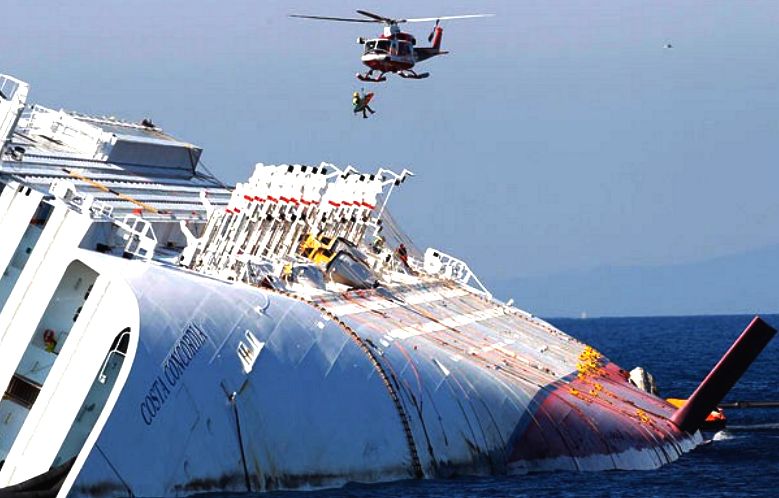
Regulatory and industry response
Corrado Clini, Italy's Minister of Environment, said that saluting, a "custom that has resulted in an outcome visible to all", should no longer be tolerated. On 23 January 2012,
UNESCO asked Italy to reroute cruise ships to avoid sailing too close to "culturally and ecologically important areas", and on 1 March, Italy excluded large ships from sailing closer than two miles from marine parks.
The European Maritime Safety Agency was in the process of conducting a review of maritime safety when the accident occurred. On 24 January 2012, Transport Commissioner Siim Kallas told the Transportation Committee of the European Parliament that lessons learned from the loss of Costa Concordia would be taken into account. British MEP Jacqueline Foster warned against "trial by television and trial by newspapers", a view that was backed by fellow British MEP Brian Simpson, who said that it was "good practice to wait for the official report".
On 18 January 2012, the Chairman of the United States House Committee on Transportation and Infrastructure announced that it would hold a hearing, conducted jointly with the Committee's Maritime Transportation Subcommittee, to "review the events of this specific incident, current safety measures and training requirements". Testimony and statements at the 29 February hearing primarily promoted North American cruise ships as being safe.
Gianni Scerni, the chairman of Registro Italiano Navale (RINA), the classification society that issued Costa Concordia a certificate of seaworthiness and safety management in November 2011, resigned on 18 January 2012.
The Cruise Lines International Association (CLIA), the European Cruise Council (ECC) and the Passenger Shipping Association adopted a new policy requiring all embarking passengers to participate in muster drills before
departure. On 29 January 2012, at Fort Lauderdale, Florida, Holland America Line made one passenger disembark from the cruise ship MS Westerdam for "non-compliance" during a mandatory muster drill. On 24 April, the CLIA and the ECC introduced new policies: bridge officers must agree on the route before departing; ships must carry more lifejackets; and access to the bridge must be limited.
In an action some parliamentarians said was a reaction to the wrecking of the Costa Concordia, the Italian government withdrew proposed legislation that would have reduced current restrictions on mineral exploration and production. On July 8, 2012 CNN reported that the disaster brought changes to safety and evacuation procedures in the cruise industry. Carnival, the parent line of Costa, and several other cruise lines now require safety instruction, referred to as muster drills, before leaving port. The new muster policy consists of 12 specific emergency instructions, which include providing information on when and how to don a life jacket, where to muster and what to expect if there is an evacuation of the ship.
Media
Coverage of the shipwreck dominated international media in the days after the disaster. The New York Times called the incident "a drama that seemed to blend tragedy with elements of farce". Phillip Knightley called it the "most significant event in modern maritime history" because "every single safety procedure designed to make sea travel safe failed miserably". Francesco Schettino was dubbed "Captain Coward" by the
Daily Mail in the UK.
UK's Channel 4 television commissioned and broadcast two programmes about the disaster. Terror at Sea: The Sinking of the Costa Concordia, broadcast on 31 January 2012, explored how and why the ship went down. The Sinking of the Concordia: Caught on Camera, broadcast on 11 April 2012, provided a minute-by-minute anatomy of the Costa Concordia disaster, made almost entirely from passengers' mobile phone and video camera footage. The documentary also featured thermal imaging footage of the stricken ship taken by the rescue helicopter, together with pilot commentary, and a recording of the conversation between the Coast Guard and the captain, during which the
Coast Guard ordered Captain Schettino to return to his ship.
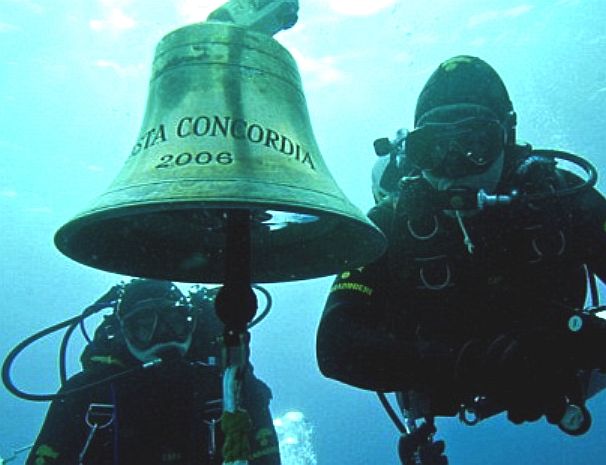
In Italy
Corriere della Sera stated that Italy owed the world a "convincing explanation" for the wreck and called for harsh punishment of those found responsible. Il Giornale said the wreck was a "global disaster for Italy". Il Messaggero said there was "anguish over those still missing". La Repubblica called the event "a night of errors and lies". La Stampa criticized the captain for not raising the alarm and refusing to go back on board the ship.
Italian commentators reflected on the contrast between Schettino and De Falco and what it said about the national character. They represented "the two souls of Italy", according to Aldo Grasso in Corriere della Sera. "On the one hand a man hopelessly lost, a coward who shirks his responsibility as a man and an officer, indelibly stained. The other grasps the seriousness of the situation immediately and tries to remind the first of his obligations."
Some saw parallels between the incident and the country's recent political upheavals. "To see someone that in a moment of difficulty maintains steady nerves is consoling because that is what we need", another Corriere della Serra columnist, Beppe Severgnini, told The
New York Times. "Italy wants to have steady nerves because we've already done the cabaret route."
De Falco's exasperated order to Schettino, "Vada a bordo, cazzo!" became a catchphrase in Italy. T-shirts with the phrase were soon printed and sold across the country. It has also been used on Twitter and Facebook. Another Italian newspaper, Il Libero, used it in a cartoon caricaturing German chancellor
Angela Merkel, shown rowing away from a ship named Europa Discordia and painted with the symbol of the European Union. It was a reaction to Germany's refusal to do more, as Monti had requested, to help lower Italy's borrowing costs.
Titanic comparison
Several media outlets have compared the ship to the Titanic. Survivor Valentina Capuano is a niece of a man who died in the
Titanic tragedy 100 years earlier. Capuano said she was "dumbstruck" that history seemed to be repeating itself. Some passengers said that the Titanic theme "My Heart Will Go On" performed by
Céline Dion, was playing in a restaurant when the ship hit the rock. Several media commentators contrasted the "women and children first" attitude generally prevailing on the RMS Titanic to the "first come, first served" attitude said to be more prevalent on the Costa Concordia, though no law requires preferential treatment of women and children when evacuating a ship in distress.
Memorial
The mayor of Giglio, Sergio Ortelli, and Costa Cruises are in agreement that the massive rock to be removed from the side of the vessel should be suitably positioned on the island as a memorial to the 32 people who lost their lives. Ortelli anticipates the rock will "most likely" be positioned "close to the harbour entrance so that visitors and locals can see it clearly and pay their respects to the victims. What happened that night is something Giglio will never forget and the rock will be a fitting memorial." The cost of removing the 80-ton rock is estimated at £40,000. There is no date yet set for the creation of the memorial.
Culture and media
In 2010, Costa Concordia provided the decadent setting for Jean-Luc Godard's film Film
Socialisme.
A documentary broadcast in the United Kingdom, titled Terror at Sea: The Sinking of the Costa Concordia, and another first broadcast on 11 April 2012 on Channel 4, titled The Sinking of the Concordia: Caught on Camera, featured footage filmed by the passengers and crew.
Furthermore, a documentary, titled Cruise Ship Disaster: Inside the Concordia, was first broadcast on the Discovery Channel, and another, titled Inside Costa Concordia: Voices of Disaster, was first broadcast by
National Geographic. The season 39 Nova episode Why Ships Sink discusses the sinking of the Concordia.
LINKS
www.collisionregs.com/Collregs.html
www.cbsnews.com
costa concordia salvaging a shipwreck
www.mirror.co.uk
costa concordia captain wasnt wearing his glasses
http://cruisemiss.com/2012/05/20/costa-concordia-year-long-refloat-operation/
http://thefreelancedesk.com/?p=927
http://www.independent.com.mt//2013-07-20/news/italy-5-convicted-for-costa-concordia-shipwreck
http://www.bbc.co.uk/news/world-europe-23388680
http://www.marinelink.com/news/convicted-concordia356819.aspx
http://news.yahoo.com/italy-5-convicted-costa-concordia-shipwreck-095940455.html

The
'Bluefish' by Bluebird Marine Systems Ltd,
is designed to carry Scorpion
anti pirate weapons. A fleet of such autonomous vessels could be the basis
of an international peacekeeping, and/or emergency rescue force.
The
COLREGs
compliant navigation system that is being developed as project
'Bluefish' could have
prevented the sinking of the Costa Concordia. This might be of interest
to fleet operators.
|










